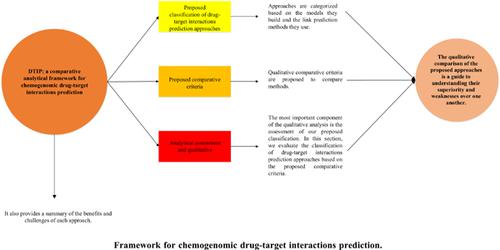Current Computer-Aided Drug Design ( IF 1.5 ) Pub Date : 2021-01-31 , DOI: 10.2174/1573409916666191218124520 Faraneh Haddadi 1 , Mohammad Reza Kayvanpour 2

|
Background: Prediction of drug-target interactions is an essential step in drug discovery. Given drug-target interactions network, the objective of this task is to predict probable missing edges from known interactions. Computationally predicting drug-target interactions is an appropriate alternative for the time-consuming and costly experimental process of drug-target interaction prediction. A large number of computational methods for solving this problem have been proposed in recent years.
Objective: In recent years, several review articles have been published in the field of drug-target interactions prediction. Compared to other review articles, this paper includes a qualitative analysis in the form of a framework, a drug-target interactions prediction (DTIP) framework.
Methods: The framework consists of three sections. Initially, a classification has been presented for drug-target interactions prediction methods based on the link prediction approaches used in these methods. Secondly, general evaluation criteria have been introduced for analyzing approaches. Finally, a qualitative comparison is made between each approach in terms of their advantages and disadvantages.
Results: By providing a new classification of the drug-target interactions prediction approaches and comparing them with the proposed evaluation criteria, this framework provides a convenient and efficient way to select and compare the methods. Moreover, using the framework, we can improve these techniques further.
Conclusion: This paper provides a study to select, compare, and improve chemogenomic drugtarget interactions prediction methods. To this aim, an analytical framework is presented.
中文翻译:

DTIP:化学基因组药物靶点相互作用预测的比较分析框架
Background: Prediction of drug-target interactions is an essential step in drug discovery. Given drug-target interactions network, the objective of this task is to predict probable missing edges from known interactions. Computationally predicting drug-target interactions is an appropriate alternative for the time-consuming and costly experimental process of drug-target interaction prediction. A large number of computational methods for solving this problem have been proposed in recent years.
Objective: In recent years, several review articles have been published in the field of drug-target interactions prediction. Compared to other review articles, this paper includes a qualitative analysis in the form of a framework, a drug-target interactions prediction (DTIP) framework.
Methods: The framework consists of three sections. Initially, a classification has been presented for drug-target interactions prediction methods based on the link prediction approaches used in these methods. Secondly, general evaluation criteria have been introduced for analyzing approaches. Finally, a qualitative comparison is made between each approach in terms of their advantages and disadvantages.
Results: By providing a new classification of the drug-target interactions prediction approaches and comparing them with the proposed evaluation criteria, this framework provides a convenient and efficient way to select and compare the methods. Moreover, using the framework, we can improve these techniques further.
结论:本文提供了一项选择、比较和改进化学基因组药物靶点相互作用预测方法的研究。为此,提出了一个分析框架。











































 京公网安备 11010802027423号
京公网安备 11010802027423号